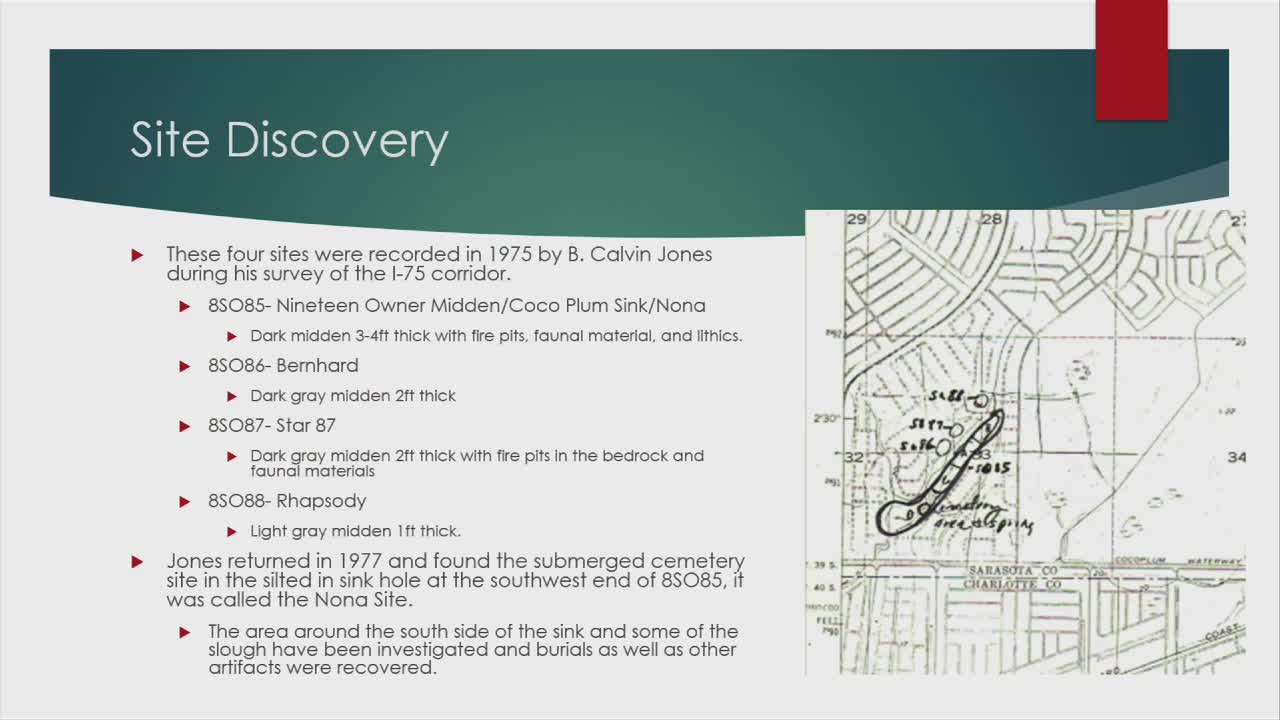Archaeologists uncover buried secrets amid development chaos
September 09, 2024 | North Port, Sarasota County, Florida
This article was created by AI summarizing key points discussed. AI makes mistakes, so for full details and context, please refer to the video of the full meeting. Please report any errors so we can fix them. Report an error »

In a recent government meeting, discussions centered around the archaeological significance of the Nona site and its surrounding areas, originally discovered in 1975 by state archaeologist B. Calvin Jones during a survey for the I-75 corridor. The meeting highlighted the complexities of archaeological site management, particularly in light of ongoing development pressures.
Jones initially identified four key sites, including the Nona and Coco Plum Sink, which have since yielded significant findings, including human remains and various artifacts. However, the integrity of these sites has been compromised due to development activities, raising concerns about the preservation of cultural heritage.
The meeting underscored the challenges faced by archaeologists in distinguishing between intact archaeological contexts, such as middens, and disturbed areas, referred to as push piles. The latter often contain artifacts but lack the integrity necessary for meaningful archaeological interpretation. Recent surveys revealed discrepancies in site mapping, prompting further investigation to clarify the extent and significance of these archaeological resources.
A notable point of discussion was the protocol for handling human remains discovered during development. Archaeologists explained their approach of temporarily removing remains for respectful storage and then reinterring them at a deeper level to prevent future disturbances. This practice, while accepted by state and federal authorities, requires careful negotiation with tribal representatives to ensure compliance with cultural sensitivities.
The meeting concluded with a call for continued surveys and monitoring of the area, as recent excavations have indicated the potential for significant archaeological findings. The ongoing dialogue between archaeologists, developers, and tribal representatives is crucial for balancing development needs with the preservation of invaluable historical resources.
Jones initially identified four key sites, including the Nona and Coco Plum Sink, which have since yielded significant findings, including human remains and various artifacts. However, the integrity of these sites has been compromised due to development activities, raising concerns about the preservation of cultural heritage.
The meeting underscored the challenges faced by archaeologists in distinguishing between intact archaeological contexts, such as middens, and disturbed areas, referred to as push piles. The latter often contain artifacts but lack the integrity necessary for meaningful archaeological interpretation. Recent surveys revealed discrepancies in site mapping, prompting further investigation to clarify the extent and significance of these archaeological resources.
A notable point of discussion was the protocol for handling human remains discovered during development. Archaeologists explained their approach of temporarily removing remains for respectful storage and then reinterring them at a deeper level to prevent future disturbances. This practice, while accepted by state and federal authorities, requires careful negotiation with tribal representatives to ensure compliance with cultural sensitivities.
The meeting concluded with a call for continued surveys and monitoring of the area, as recent excavations have indicated the potential for significant archaeological findings. The ongoing dialogue between archaeologists, developers, and tribal representatives is crucial for balancing development needs with the preservation of invaluable historical resources.
View full meeting
This article is based on a recent meeting—watch the full video and explore the complete transcript for deeper insights into the discussion.
View full meeting